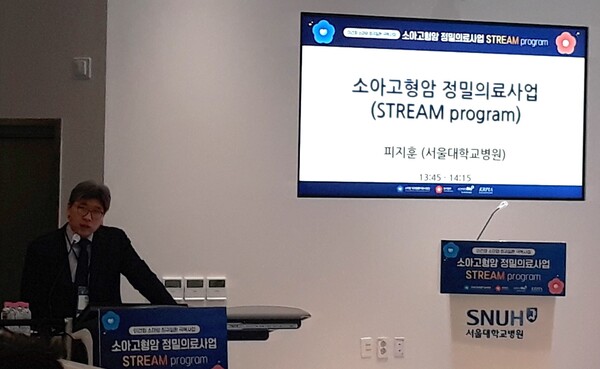Precision medicine is changing the treatment performance of many adult cancers, including lung, colon, and breast cancer. By identifying the "driver gene mutations" that cause cancer and targeting them with therapies, the cure rate is increasing. What about pediatric cancers, however?
It is widely understood that identifying driver gene mutations in pediatric cancers, akin to adult cancers, can lead to improved outcomes. However, pediatric cancers still face challenges in the starting phase of diagnosis; the core of precision medicine and access to treatments remains an unsolved task.

Professor Phi Ji-hoon, who heads the solid tumor division of the Pediatric Cancer and Rare Disease Support Project Corps, pointed to the poor diagnosis and treatment realities faced by children with solid tumors at a symposium on the STREAM Program, a precision medicine project for pediatric solid tumors, last Friday.
"Pediatric solid tumors are very difficult to diagnose. The number of cases is small, and when divided into individual organs, they all fall into rare cancers. Without the help of molecular biology, it is difficult for even the most experienced medical professionals to diagnose because they often encounter it for the first time," Professor Phi said. There are also many systemic constraints on diagnosis.
Most hospitals do not perform enough tests due to systemic constraints, including cost and manpower. In particular, Phi noted that germline mutations are rarely evaluated in children.
Germline mutations are genetic mutations passed down from parents and are distinct from somatic mutations specific to each individual.
Unlike adult cancers, it is necessary to identify germline mutations to characterize childhood cancers without significant environmental influences, which is currently almost impossible.
One reason for this is the poor infrastructure for pediatric cancer.
"There are very few pathologists in general and even fewer pathologists who see pediatric cancer; some hospitals don't even have one. It would be fortunate if there's one in each province," he said. "More problematically, many patients must come to a hospital in Seoul because they can't be diagnosed even after surgery."
Even hospitals that have diagnostic systems are not without problems.
"In recent years, 'targeted sequencing' has been introduced, which only looks at gene mutations targeted by hospitals. However, there is a problem because some hospitals are relatively good at it, but others can target only a few," Professor Phi said.
Targeted sequencing examines only gene mutations that the hospital has targeted. If many targets with high domestic expression are targeted well, it is likely to filter out mutations that the patient has. However, if they target only a few, it is difficult to filter out mutations properly.
In addition, in the case of pediatric cancer, there is no tissue bank in each hospital or only a few decentralized tissue bank networks operated by each medical center. Hence, the infrastructure required for precision diagnosis of rare pediatric cancers is poor.
Against this backdrop, a wind of change came through the Stream Program of the Pediatric Cancer and Rare Disease Support Project in February last year.
"The Stream Program provides the most accurate molecular pathological diagnosis by obtaining the latest whole genome sequencing (WGS) results for all pediatric solid tumors," Phi said, adding that a new diagnostic system has been created in Korea over the past year.
An infrastructure to improve the diagnostic accuracy of pediatric solid tumors through collective intelligence has also been established.
"We have created a pathology committee chaired by Professor Kim Se-yoon of the Department of Pathology at Yonsei University College of Medicine to review the diagnosis through online meetings of pathologists who can see pediatric cancer," Professor Phi said.
A pipeline of genetic analyses dedicated to pediatric cancer has also been established.
"Just as there are no clinical trials and no drugs for children, there was no pipeline for pediatric genetic analysis. Most cancer genetic analysis pipelines targeted adult cancers, so they were not suitable for pediatric cancers," Phi said, adding that the team has been working on a highly sophisticated genetic analysis pipeline for pediatric cancers over the past year.

The team has also established a program to partner with the biotech industry to provide solutions specific to pediatric cancer. "It's a program that applies the drug library to the cancer cells of the patient and provides a report on which anti-cancer drugs to use," Phi said. "We are testing new drugs in addition to existing drugs, testing between 30 and 100 drugs and receiving the results."
As the diagnosis of pediatric solid tumors has become more accurate and treatment solutions have become more available, other challenges have become more prominent in the Stream Program, which aims to smooth the flow of diagnosis and treatment. That revealed the Korean reality of not having access to treatments for children with solid tumors in time for a precise diagnosis.
At the symposium, Professor Phi introduced that he applied the Stream Program to a seven-year-old patient with diffuse midline glioma, a pediatric cancer with the worst prognosis of 100 percent mortality, and found the BARD1 gene mutation as a cancer driver gene through genetic analysis tests.
As PARP1 inhibitors, including olaparib, have recently been shown to be effective against BARD1 gene mutations, the Stream Program offered a clinical trial of this drug as a solution. However, in the end, the child with the glioma died without using a PARP1 inhibitor.
"We recommended a therapeutic solution, but it didn't materialize," Phi said. "We realized that it's not an easy problem, such as whether you can get the drug. A doctor has to make the document when patients seek the drug, but one cannot find such a doctor easily."
Professor Koh Kyung-nam of the Department of Pediatrics and Adolescents at Asan Medical Center in Seoul said, "The process of importing drugs that are not available in Korea is very difficult, and even if domestic drugs are introduced, there is no way to use them without indications. It is possible to use it compassionately, but it requires permission from the Ministry of Food and Drug Safety, and it takes a lot of effort because it requires documents and administrative work."
In addition, to apply for approval for therapeutic use in pediatric solid tumors, all rare cancers, it is necessary to provide evidence to apply for the drug. However, it is difficult to obtain approval because all pediatric cancers are rare, and almost no pediatric studies have been conducted. Therefore, if there is evidence for adult cancers related to treating the target gene, it is also necessary to approve it, Professor Koh explained.
"Pharmaceutical companies do not conduct clinical trials on children because they have already been approved in adults," Koh said. "I hope that the MFDS will consider whether there are any prospective changes that can be made to the approval process for children, which will ultimately benefit patients."
Professor Sung Ki-woong of the Department of Pediatrics at Samsung Medical Center said, "Pediatric cancer has been a low priority for the government, and only limited clinical trials have been conducted in children. We need to bring electricity to pediatric cancer, which is being treated with cytotoxic anti-cancer drugs developed 30 to 40 years ago."
Experts believe that collaboration among pediatric cancer specialists, along with public and private stakeholders, is essential to bridging the gap in diagnosis and treatment flow, leading to improved outcomes.
"The right way is to collaborate with various biotech companies and pharmaceutical companies on a broader scale to find vulnerabilities in cancer and conduct clinical research and drug testing on our own," Professor Phi said. “I hope that all parties involved will work together to improve the survival rate of childhood cancer patients in Korea.”

